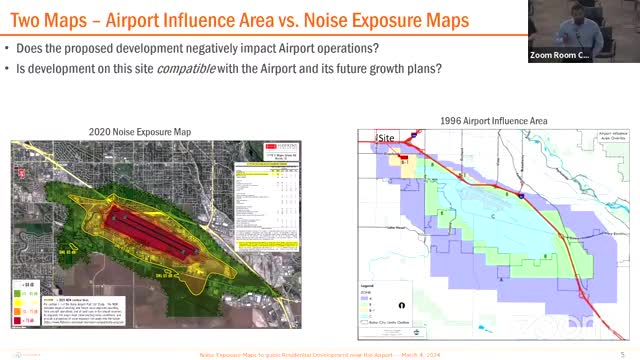Boise airport noise maps spark debate over residential development
July 09, 2024 | Boise City, Boise, Ada County, Idaho

This article was created by AI summarizing key points discussed. AI makes mistakes, so for full details and context, please refer to the video of the full meeting. Please report any errors so we can fix them. Report an error »

In a recent government meeting, discussions centered on the compatibility of residential development near Boise Airport, particularly regarding noise exposure maps (NEMs) and the airport influence area (AIA). The city officials emphasized their commitment to ensuring that any new projects would not negatively impact airport operations or the Idaho Air National Guard.
The meeting highlighted the importance of using updated noise exposure maps, which are based on modern data and federal guidelines, to inform land use decisions. The latest NEM, created in 2020, indicates that residential development is compatible in areas where noise levels are below 65 decibels. Officials pointed out that the current residential development proposals are located outside this noise contour, suggesting compatibility with airport operations.
In contrast, the AIA, which has not been updated since the 1990s, was described as overly conservative. Officials noted that while the AIA was designed to mitigate neighborhood concerns, it relies on outdated data that does not reflect current aircraft noise levels or operational frequencies. They argued that the NEMs, which are updated every five years, provide a more accurate representation of noise exposure and should guide future growth.
The discussion also touched on the potential implications for airport funding, as the Federal Aviation Administration (FAA) uses noise exposure maps to determine grant eligibility. Officials expressed concern that adhering strictly to the outdated AIA could jeopardize funding opportunities, as compatibility with noise exposure levels is a key factor in grant assessments.
Questions from the commission further explored the subjective nature of noise perception and its impact on residential living. The airport staff clarified that while aircraft are becoming quieter, increased operations could still lead to greater noise exposure, complicating the compatibility assessment.
Overall, the meeting underscored the need for a balanced approach to land use planning that considers both the evolving nature of airport operations and the community's residential needs. The officials urged for the adoption of the updated noise exposure maps to ensure responsible development that aligns with current data and regulations.
The meeting highlighted the importance of using updated noise exposure maps, which are based on modern data and federal guidelines, to inform land use decisions. The latest NEM, created in 2020, indicates that residential development is compatible in areas where noise levels are below 65 decibels. Officials pointed out that the current residential development proposals are located outside this noise contour, suggesting compatibility with airport operations.
In contrast, the AIA, which has not been updated since the 1990s, was described as overly conservative. Officials noted that while the AIA was designed to mitigate neighborhood concerns, it relies on outdated data that does not reflect current aircraft noise levels or operational frequencies. They argued that the NEMs, which are updated every five years, provide a more accurate representation of noise exposure and should guide future growth.
The discussion also touched on the potential implications for airport funding, as the Federal Aviation Administration (FAA) uses noise exposure maps to determine grant eligibility. Officials expressed concern that adhering strictly to the outdated AIA could jeopardize funding opportunities, as compatibility with noise exposure levels is a key factor in grant assessments.
Questions from the commission further explored the subjective nature of noise perception and its impact on residential living. The airport staff clarified that while aircraft are becoming quieter, increased operations could still lead to greater noise exposure, complicating the compatibility assessment.
Overall, the meeting underscored the need for a balanced approach to land use planning that considers both the evolving nature of airport operations and the community's residential needs. The officials urged for the adoption of the updated noise exposure maps to ensure responsible development that aligns with current data and regulations.
View full meeting
This article is based on a recent meeting—watch the full video and explore the complete transcript for deeper insights into the discussion.
View full meeting